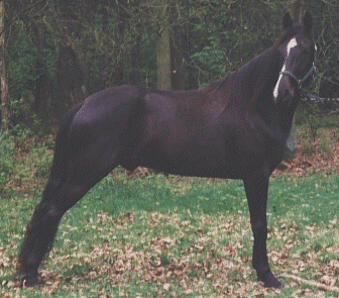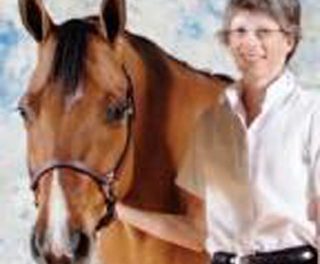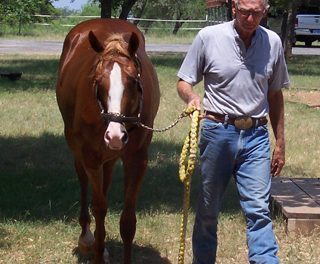Practice makes perfect – yes? Not always – too much practice can create problems.
Yes, our horses do have to practice in order to perfect movements, but there can come a time when, because of practicing one particular thing over and over again, their bodies begin to lose the ability to do other movements easily.
What makes this happen? As a horse practices moving in a certain way, a movement pattern can gradually become so firmly entrenched the body loses the flexibility to use itself in other ways. The muscles tighten into a pattern that is comfortable just performing in that one way; other movements become difficult. Muscles and tendons begin to develop in a way that accomplishes one movement well, but begins to lose the flexibility to do other movements equally as well. The muscles become “specialist” that do one thing very well, but may not have a wide variety of equal skills.
So, is it bad to want our horse to be “specialist”? No! If we want an athlete to excel in an activity, the muscles have to develop the muscle memory to learn to perform basically on a subconscious level. The movements have to enter into the subconscious and become habitual. The horse will have to respond without having to really think about what you have asked it to do. And this is good; BUT there is a down side. Not only is the flexibility to do other movement sacrificed, but this over-use of the muscles in just one pattern can lead to sore muscles and damage to muscles and tendons; and in addition to the muscle soreness and injuries, this muscle constriction can, in the long run, hinder the very movement or activity all that practicing was meant to perfect. Too much repetition of muscular movements can eventually create muscles and tendons that have become so strong in contraction they not only begin to suffer from muscle spasms and soreness, but, more importantly, their constriction around joints can cause pain and inflammation and restrict joint movement.
The name given to the problems or injuries that can result from this joint constriction by over-developed muscles is “repetitive-use injuries”.
Repetitive-use injuries are not the same as injuries that can happen to any horse doing its job; these are injuries that develop when a horse is confined to a “set” way of moving that forces it to use muscles over and over, day in and day out, without the relief of working the muscles in different ways.
Probably the most well known repetitive-use injury in people is carpal tunnel syndrome. Carpal Tunnel is caused by the constant repetitious motion of fingers on the keyboard of computers (or typewriters), or any other repetitive movements of the fingers. Other repetitive use injuries in people that you would recognize are tennis elbow, injuries to baseball pitcher’s pitching arms, or problems in hip and shoulder joints of golfers – and our farrier’s back problems from bending over while working on our horses day in and day out. My farrier has a complete exercise regime to avoid this.
Our horses can suffer from repetitive-use injuries just as people do. Horses are prone to these same types of problems due to some of the jobs they are asked to do. Many of the things we ask horses to do involve using their muscles and joints in the same patterns day after day. And then, many of these horses spend the rest of their day standing in a stall instead of being able to move around and use their muscles in other ways.
What are some of the things we ask horses to do that could result in repetitive-use problems or injuries? I am going to describe a few that I am familiar with where the whole principle of the training and performance sets a horse up for repetitive-use injuries. There are others where some phases of training can produce some of the results I’m describing. Perhaps you, the reader, can think of other kinds of training and riding that can produce problems or injuries because a horse is asked to do the same things in the same way over and over again, day in and day out, without some other activities to relieve a build-up of tension in the muscles.
I’ll start with hunters. In order to be competitive, these horses are ridden in a “frame” on the flat and over jumps, and they are routinely ridden in a standing martingale to help maintain that frame. The courses are designed in a way that requires horses to conform to certain numbers of strides between jumps, especially those in combinations. Horses are penalized for not conforming to the required strides with little regard for their natural length of stride. All of this puts stress on these horse’s backs and hocks. Sore backs are common in hunters. And is it possible that this way of training and riding could account for why so many of the horses shown as hunters seem to end up needing hock injections?
The western pleasure horse is typically “on the forehand” with well developed forehand muscles and a low neck carriage that puts a lot of weight on its forehand. In addition, western pleasure requires that these horses go as slow as possible with short strides that use an up/down motion with their legs. The muscles that produce this short up/down motion become over-developed and the horse loses its capacity for longer strides. All three gaits (walk, jog, lope) are involved and this restricted movement puts great stress on the horse’s body and legs, especially the front legs. In some cases, movement can become so restricted that the gaits lose their purity and you will see horses jogging with their front legs and walking with the hind legs. In the lope you may see horses loping in front and jogging behind.
The Paso Fino is another horse that is very susceptible to repetitive-use problems or injuries because all of its gaits are the four beat walk sequence done at different speeds. These horses do not have a trot. They can canter, but most are not allowed to because riders fear ruining the gaits. This is unfortunate because cantering would give these horses the opportunity to vary the way they use their muscles. The traditional tack used on the Paso Fino also compounds the problem by restricting the strides of the hind legs. These horses are susceptible to back and hind leg problems as well as shoulder soreness.
So far I’ve described horses that have their movement shortened and restricted by constant repetition of one way of using the body, but repetitive-use problems can also affect horses that use their bodies in a long frame with long strides. The endurance horse is one of these. These horses travel in a long frame over many miles in their training and competition. Their job has them using their bodies in a long, ground-covering frame day after day. This longitudinal extension of their bodies limits their lateral flexibility and put stress on the long back muscles and hind legs. Sore backs and hind leg problems are a constant concern in endurance horses.
Our horses do need to practice in order to be good at their jobs, but too much use of their bodies in one particular way can eventually have negative effects on their performance as well as causing injuries; their muscles simply tighten up so much they lose the ability to do their job well.
So, is there any way to keep a horse at peak performance without developing repetitive-use problems or injuries? Yes – it is called cross-training. Cross-training involves using muscles in other than the usual way in order to maintain their flexible and range of motion. It’s easy to do and pays dividends in prolonging high performance as well as longevity for the horse’s body and joints.
Human athletes routinely use cross-training. One sports massage therapist told a story of a group of weight lifters that had reached the maximum of what they could lift. In an experiment, these men were divided into two groups. One continued to lift weight in their usual way while the other group started doing stretching exercises in between their weight lifting sessions. This second group was able to increase the weight they were able to lift while there was no change for the first group.
In the horse world there is a sport that is organized cross-training – eventing. Event horses do suffer injuries, but they are not from repetitive use. The event horse does dressage that focuses on flexibility and control, and the cross-country phase has the horse stretching muscles as it gallops across long distances and jumping out of that gallop. In the stadium jumping the horse is asked to use its body in jumping big fences with quick turns and “tricky” combinations.
There are less strenuous ways to cross-train. Something as simple as letting the hunter occasionally gallop freely forward in a natural frame (no martingale) is a form of cross-training. Letting the Paso Fino canter is cross-training. Simple bending exercises are cross-training for the endurance horse, and asking the western pleasure to stretch its body into a trot or canter, do some simple bending exercises or jump some small cross-rails is cross-training.
One rider had her own version of cross-training. She said that if, when she mounted, her horse wanted to collect, she did lengthening work; if it wanted to lengthen, she collected.
However you do it, cross-training will benefit your horse’s performance and comfort.
Betty Linquist is an Equine Massage Course Instructor and can be contacted through www.HorseCoursesOnline.com





